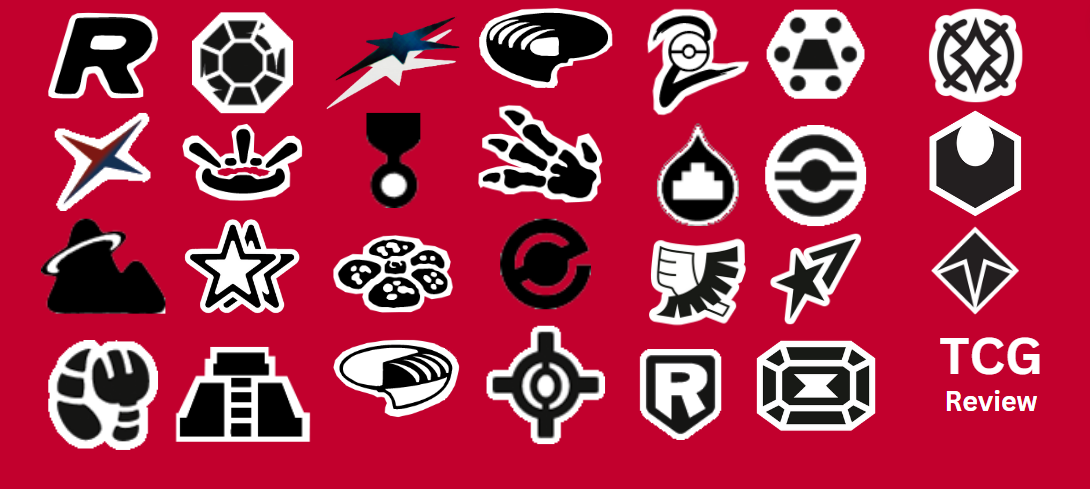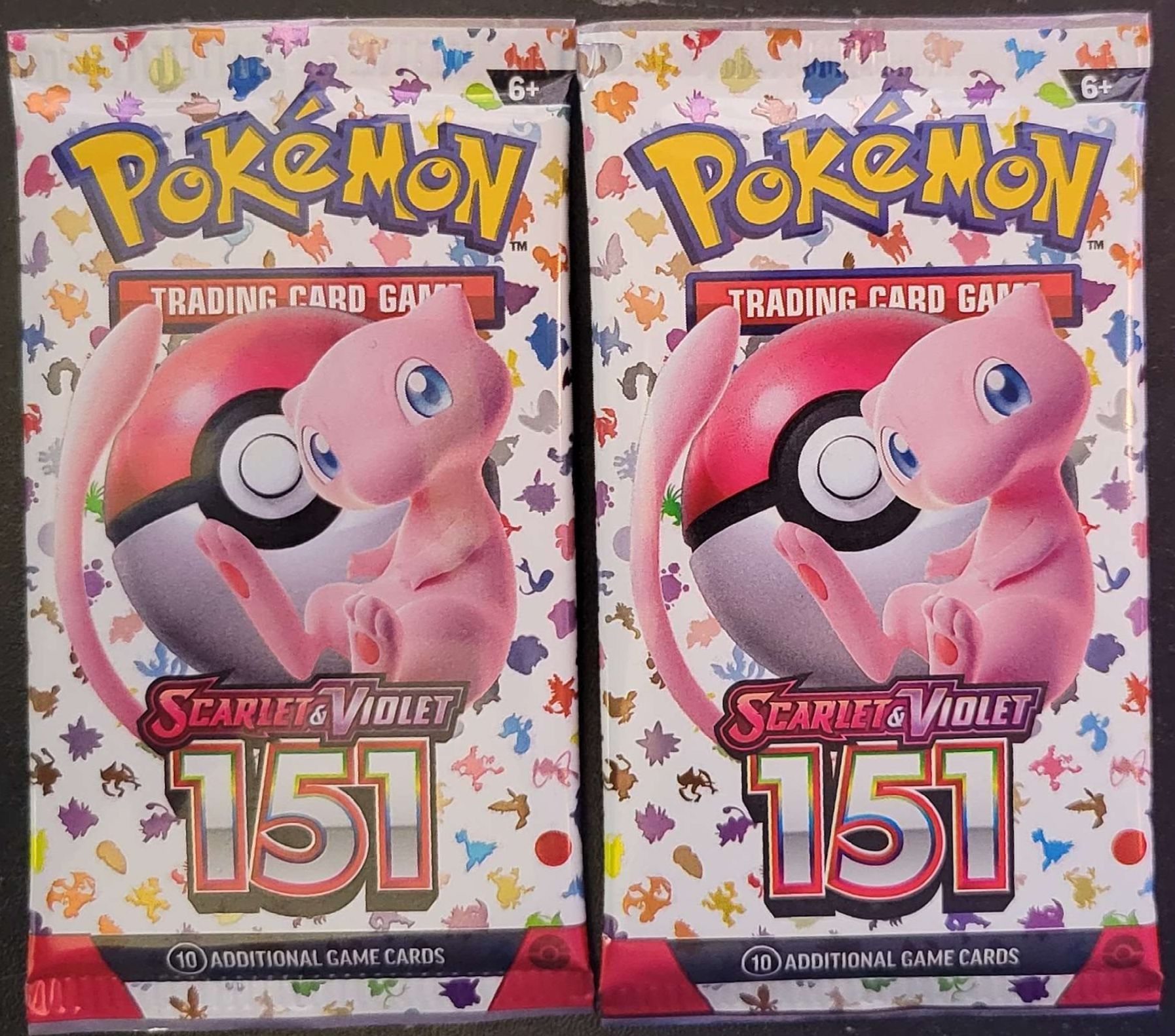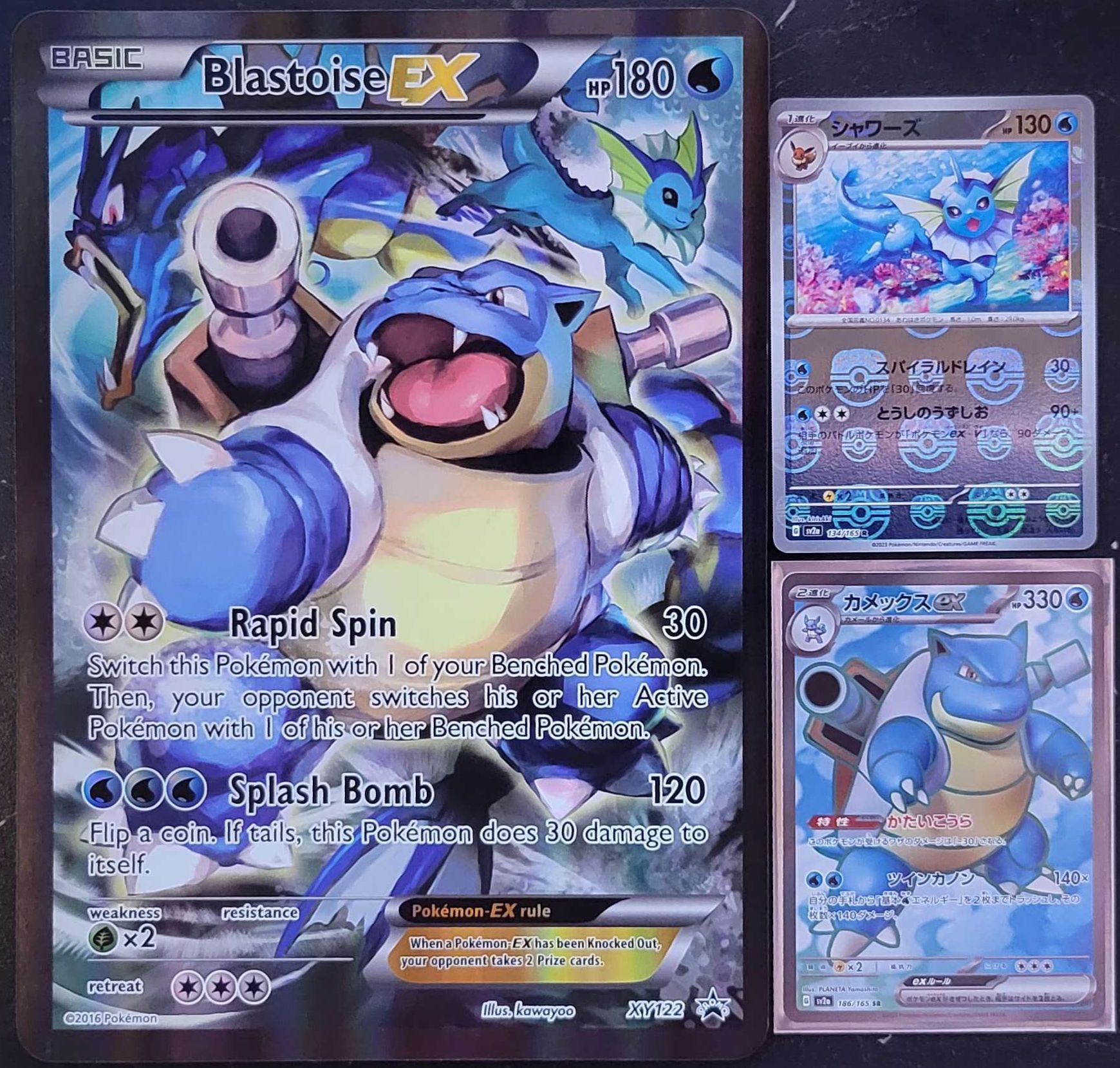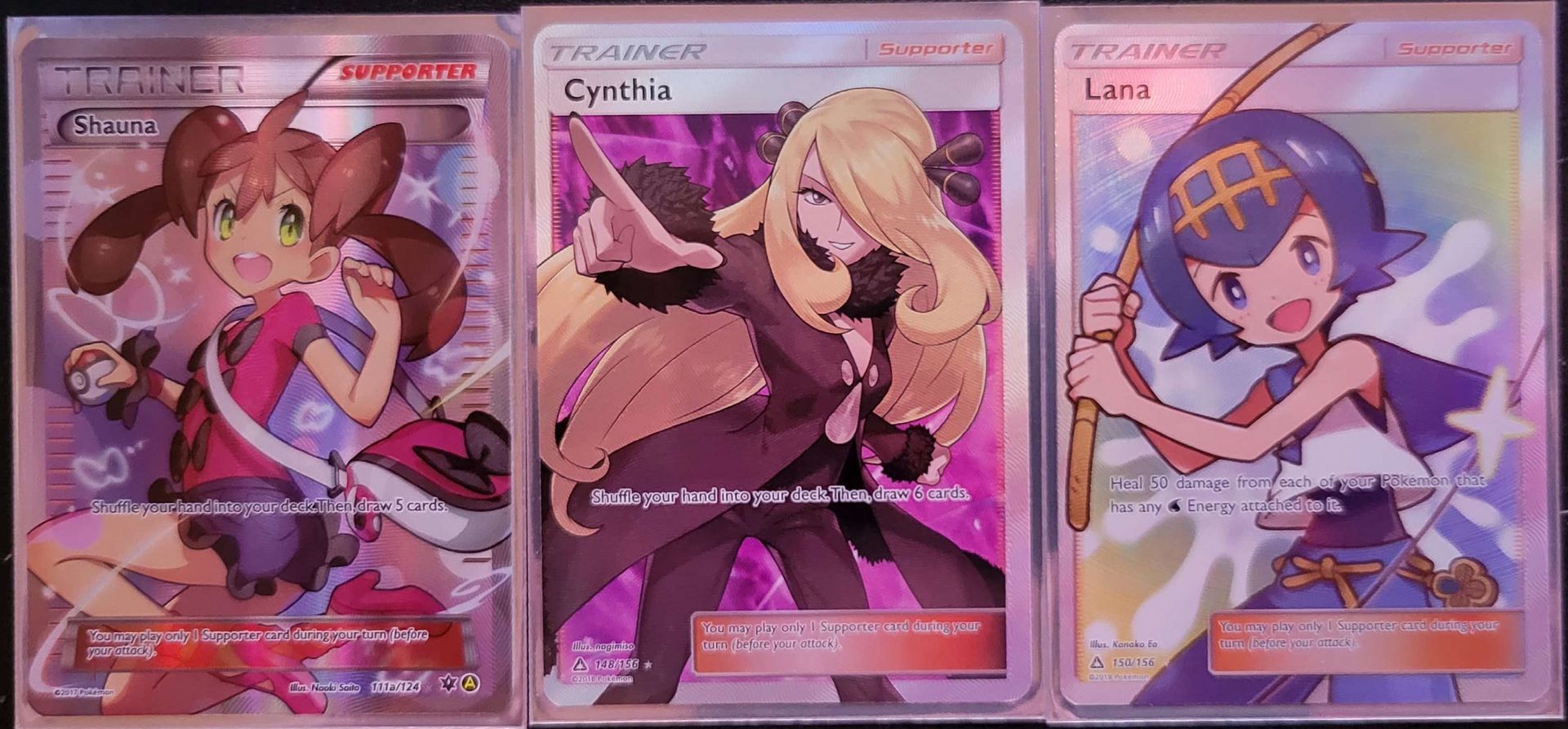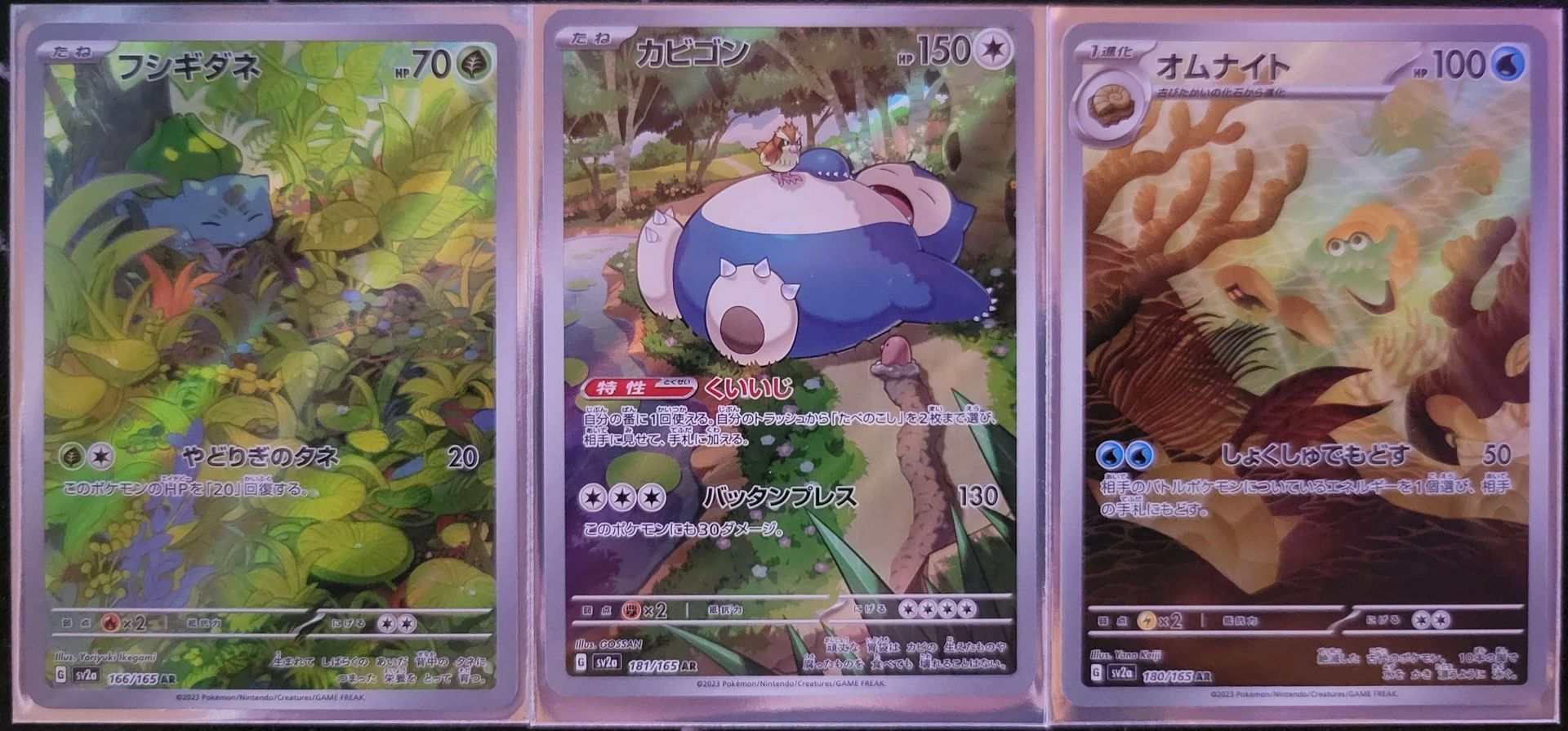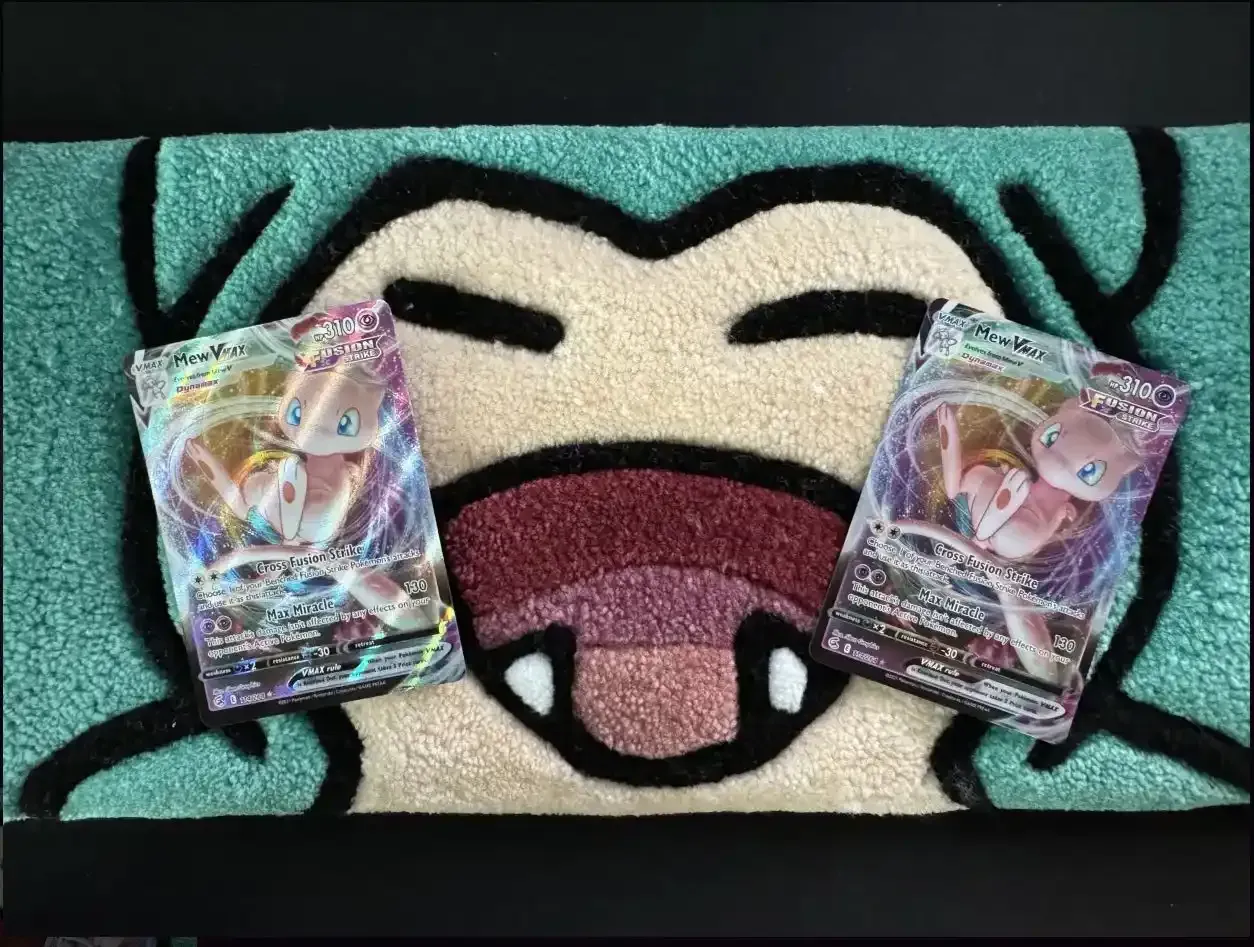All Pokémon Energy Cards in 2024
Pokémon Energy cards have been a staple in the Pokémon Trading Card Game since its initial release in the United States in 1999. Given that it is now 2024, you may be curious about the current types of energy cards in the trading card game, especially considering Pokémon celebrated its 25th anniversary last year. The list has expanded significantly over the years, with some Energy cards even leaving the game. In this article, we will explore the function of Energy cards, discuss the nine Basic Energy cards, and take an in-depth look at all the Special Energy cards (trust me, there is a bunch). So look no further – all your Pokémon Energy card questions are about to be answered!
Table of Contents
What are Pokémon Energy cards?
Energy cards are fundamental components that players use to power their Pokémon's attacks and abilities. These cards represent the energy required for Pokémon to perform various actions during a match. Without the required amount of Energy attached to your Pokémon, under normal circumstances, your Pokémon will not be able to attack or retreat.
There are two main classes of Energy cards in the Pokémon Trading Card Game: Basic Energy cards and Special Energy cards. First, let's identify what each Basic Energy card symbol looks like and what it's for.
Energy Symbols
All Pokémon Energy cards have symbols to indicate the type of energy they provide. Pokémon cards, however, display symbols representing the required energy types for their attacks. Players must match these symbols with the appropriate Energy cards to use those attacks. Pokémon Energy symbols can be found in five places: attack cost, Weakness, Resistance, Retreat Cost, and Pokémon type. I have provided a list below that will show you what each Pokémon Energy symbol looks like.
List of Services
-
Leaf SymbolList Item 1
This symbol represents the Grass Energy Pokémon type.
-
Water Droplet SymbolList Item 2
This symbol represents the Water Energy Pokémon type.
-
Fire SymbolList Item 3
This symbol represents the Fire Energy Pokémon type.
-
Lighting Bolt SymbolList Item 4
This symbol repesents the Lighting Energy Pokémon type.
-
Eye Symbol
This symbol represents the Psychic Energy Pokémon type.
-
Fist Symbol
This symbol represents the Fighting Energy Pokémon type.
-
Upside Down Crescent Moon Symbol
This symbol represents the Darkness Energy Pokémon type.
-
Grey and Metallic Triangle Symbol
This symbol represents the Metal Energy Pokémon type.
-
Pink, Angel-like Wing Symbol
This symbol represents the Fairy Energy Pokémon type.
Now that you know what each Pokémon symbol looks like, it's time to explore the ten different types of Basic Energy cards.
Basic Energy Cards: The Foundation
There are currently nine basic types of Energy cards corresponding to the Pokémon types: Grass, Fire, Water, Lightning, Psychic, Fighting, Dark, Metal, and Fairy. Now, if you want to be more critical, there is technically a tenth Energy card, which would be a Normal Energy card. However, because all Basic Energy cards can produce Normal Energy, Normal Energy cards now usually fall under the category of Special Energy cards. Nonetheless, we will still cover it.
A few points that are useful when it comes to Basic Energy cards before we dive into each of them:
- Each Basic Energy card provides one unit of its associated energy type.
- Players can include any combination of Basic Energy cards in their decks to meet the energy requirements of their Pokémon.
- There is no strict limit on the number of Basic Energy cards you can include in your deck.
That being said, having a good balance of Basic Energy cards to Pokémon is extremely important when you are learning how to build a Pokémon deck. So, make sure you don't go overboard with your Basic Energy cards because, as important as they are, balance is essential for quality deck building.
1. Grass Energy
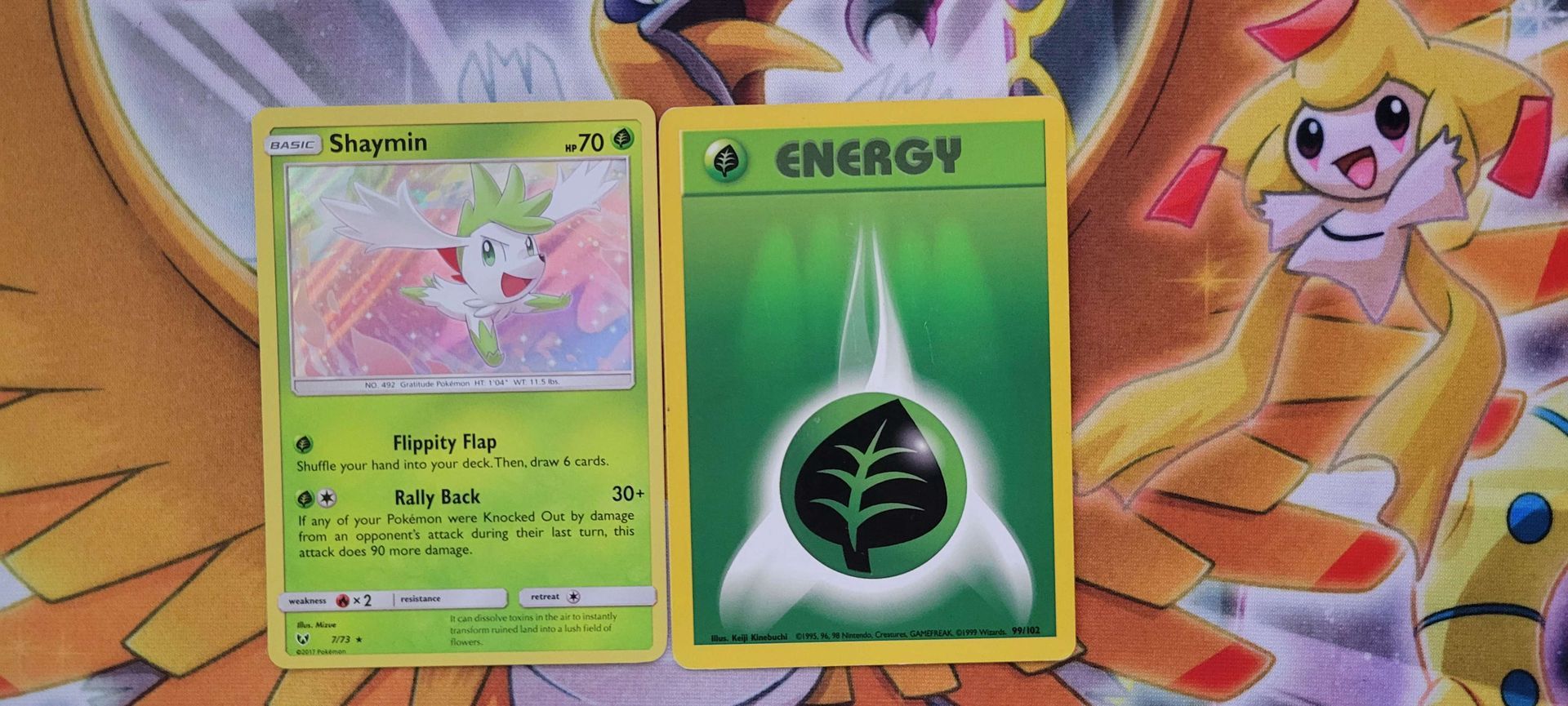
The first Basic Energy card we are going to cover is Grass Energy. I chose to start with Grass Energy because it is one of the three basic elemental types, along with Fire and Water, making it a great starting point. I mean, who doesn't like Bulbasaur? He is a little mean green fighting machine!
Grass Energy Breakdown:
- Each Grass Energy card produces either one single unit of Grass Energy or one Colorless Energy.
- You can identify a Grass Energy card by the green leaf symbol.
- Grass Energy cards enable Grass-type Pokémon to use their attacks. Many Grass-type Pokémon have powerful and strategic moves that require Grass energy, making these cards essential if you are considering using Grass-type Pokémon in your decks.
-
Type Advantage: Grass-type Pokémon often have attacks that exploit the weaknesses of Water and Ground types, which are common in the TCG. This can give Grass decks a strategic advantage against opponents using these types.
-
Energy Acceleration: Some Grass-type Pokémon and Grass-related cards provide energy acceleration, allowing players to power up their Pokémon more quickly. This can be advantageous for launching powerful attacks earlier in the game.
-
Status Conditions: Grass-type moves in the TCG may have effects that induce status conditions on the opponent's Pokémon, adding a control aspect to Grass decks.
-
Versatility in Moves: Grass-type Pokémon cards may offer a variety of moves, including healing and support options. This versatility can provide tactical advantages in different game situations.
-
Weakness to Fire-Type Pokémon: Grass-type Pokémon often have a weakness to Fire-type Pokémon in the TCG. Decks with strong Fire-type attackers can exploit this weakness, dealing extra damage to Grass Pokémon.
-
Limited Offensive Coverage: Grass decks may struggle against certain types, especially those not weak to Grass attacks. Building a diverse deck that can handle various threats is crucial to overcome this limitation.
-
Dependence on Special Energy: Some Grass-type Pokémon may rely on specific Grass-type special energy cards for their optimal performance. Dependence on special energy makes them vulnerable to disruption from cards that target energy attachments.
-
Common Weaknesses: Grass-type Pokémon may share common weaknesses with other types, such as Flying or Bug. This can make them susceptible to specific strategies and cards that exploit these weaknesses.
2. Fire Energy
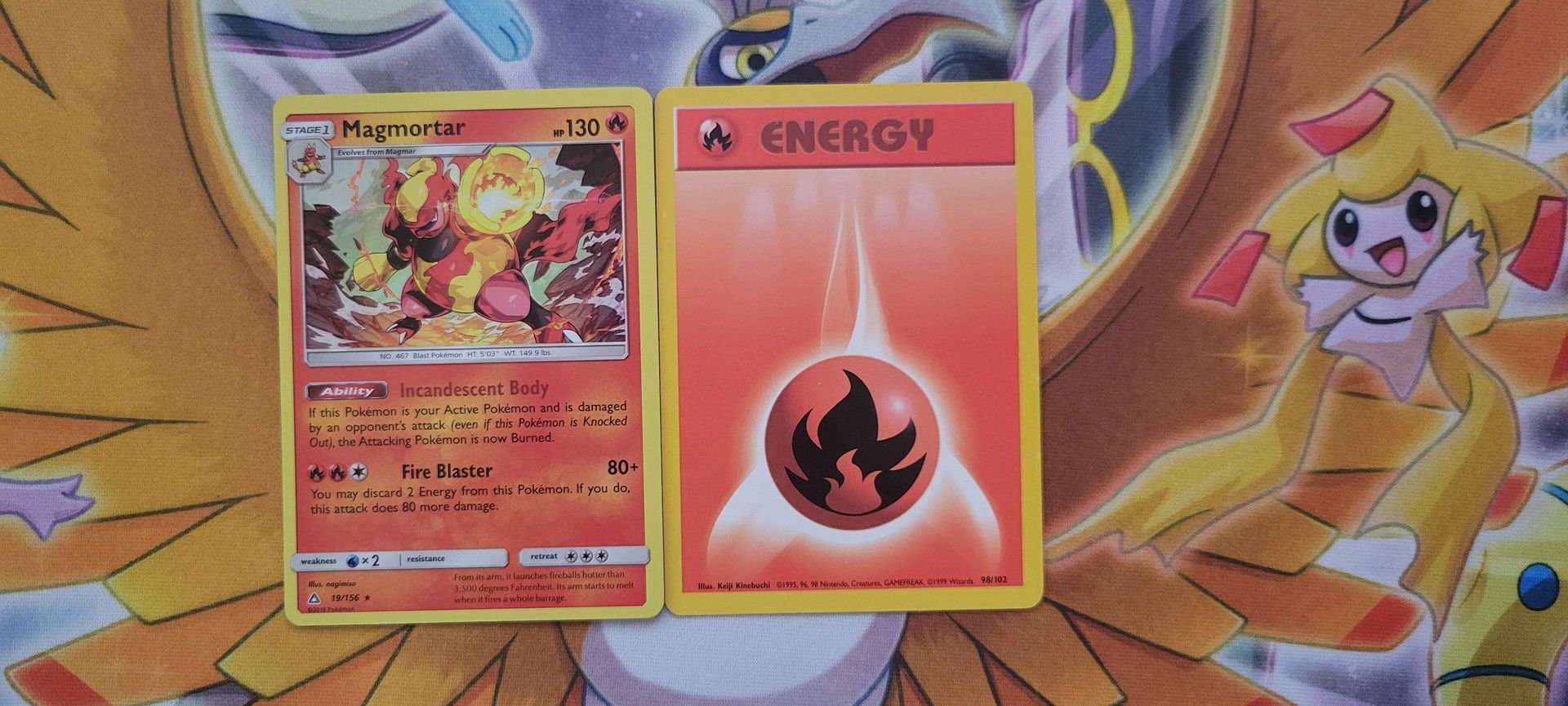
Continuing with the starter types, you already know we gotta bring the heat and start talking about Fire Energy. Now, the Fire Energy card is one of my favorite Energy cards and my favorite Pokémon types because, you guessed it, Charizard. Stack some Fire Energy cards with some hard-hitting moves, and it really is a blast.
Fire Energy Breakdown:
- Each Fire Energy card produces either one single unit of Fire Energy or one Colorless Energy.
- You can identify a Fire Energy card by the red fire symbol.
- Fire Energy cards enable Fire-type Pokémon to use their attacks. Most Fire-type Pokémon have very strong abilities requiring multiple Fire Energy cards to be equipped, making it very important if you are set on creating a Fire-type Pokémon deck.
-
Type Advantage: Fire-type Pokémon often have attacks that exploit the weaknesses of Grass-type Pokémon, which are prevalent in the TCG. This gives Fire decks a strategic advantage against opponents using Grass types.
-
High Damage Output: Fire-type Pokémon frequently boast powerful attacks with high damage output. This allows Fire decks to quickly eliminate opposing Pokémon, putting pressure on the opponent.
-
Energy Acceleration: Some Fire-type Pokémon and related cards provide energy acceleration, allowing players to power up their Pokémon rapidly. This can be crucial for launching aggressive attacks early in the game.
-
Burn Effects: Fire-type moves in the TCG may have effects that inflict the Burn condition on the opponent's Pokémon. This adds a control aspect to Fire decks, potentially disrupting the opponent's strategy.
-
Weakness to Water-Type Pokémon: Fire-type Pokémon often have a weakness to Water-type Pokémon in the TCG. Decks with strong Water-type attackers can exploit this weakness, dealing extra damage to Fire Pokémon.
-
Limited Defensive Options: Fire decks may lack strong defensive options, focusing more on offense. This leaves them vulnerable to strategies that disrupt their energy acceleration or target their key Pokémon.
-
Dependence on Special Energy: Some Fire-type Pokémon may rely on specific Fire-type special energy cards for optimal performance. Dependence on special energy makes them susceptible to disruption from cards that target energy attachments.
-
Common Weaknesses: Fire-type Pokémon may share common weaknesses with other types, such as Ground or Rock. This commonality can make them susceptible to specific strategies and cards that exploit these weaknesses.
3. Water Energy
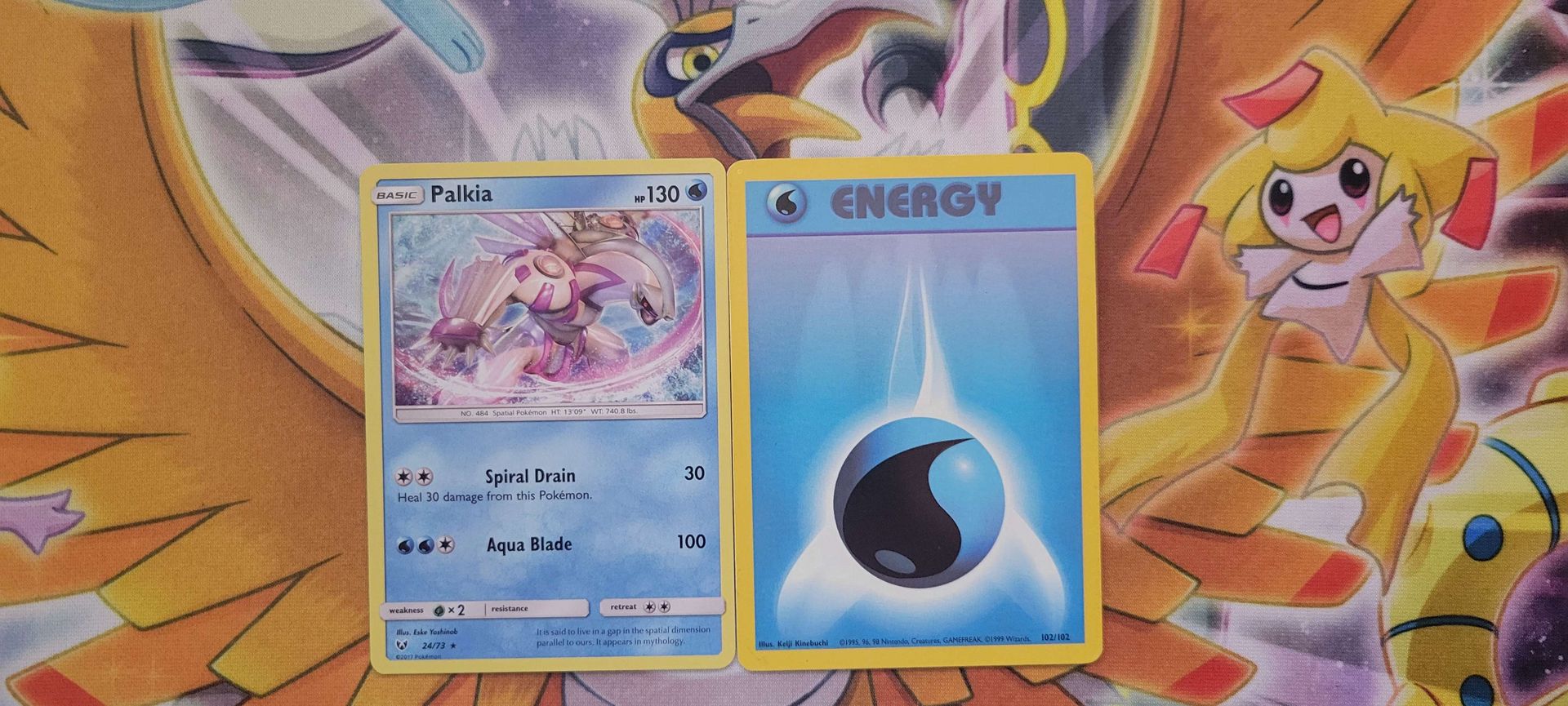
In order and exactly where we need to be, I'm talking about our third Basic Energy card: Water Energy. Now, Water Energy is always an awesome type and is home to some of the coolest Pokémon, including our final starter, Squirtle, or even that awesome Palkia you see above. Water Energy cards are essential in all Water-type Pokémon decks, so let's get into our breakdown.
Water Energy Breakdown:
- Each Water Energy card produces either one single unit of Water Energy or one Colorless Energy.
- You can identify a Water Energy card by the teardrop or water droplet symbol.
- Water Energy cards enable Water-type Pokémon to use their attacks. Just like Fire and Grass, Water-type Pokémon revolve around Water Energy cards. If you are going to make a Water-type deck, make sure your deck is well-equipped with Water Energy, or you might run into a waterfall of problems.
-
Type Advantage: Water-type Pokémon often have attacks that exploit the weaknesses of Fire-type Pokémon, which are common in the TCG. This provides Water decks with a strategic advantage against opponents using Fire types.
-
Versatility in Energy Requirements: Water-type Pokémon usually have diverse energy requirements, allowing them to fit into a variety of decks. This versatility in energy needs can make it easier to build cohesive and flexible decks.
-
High-HP Pokémon: Water-type Pokémon occasionally have higher HP (hit points) compared to other types. This increased durability allows them to withstand attacks and stay on the field longer.
-
Energy Acceleration: Some Water-type Pokémon and Water-related cards provide energy acceleration, facilitating the rapid power-up of Pokémon. This can be advantageous for executing powerful attacks early in the game.
-
Weakness to Grass-Type Pokémon: Water-type Pokémon often have a weakness to Grass-type Pokémon in the TCG. Decks with strong Grass-type attackers can exploit this weakness, dealing extra damage to Water Pokémon.
-
Limited Offensive Coverage: While Water-type Pokémon are effective against Fire types, they may have limited offensive coverage against certain other types. Building a diverse deck that can handle various threats is essential.
-
Dependence on Special Energy: Some Water-type Pokémon may rely on specific Water-type special energy cards for optimal performance. Dependence on special energy makes them vulnerable to disruption from cards that target energy attachments.
-
Common Weaknesses: Water-type Pokémon may share common weaknesses with other types, such as Electric or Fighting. This commonality can make them susceptible to specific strategies and cards that exploit these weaknesses.
4. Lightning Energy
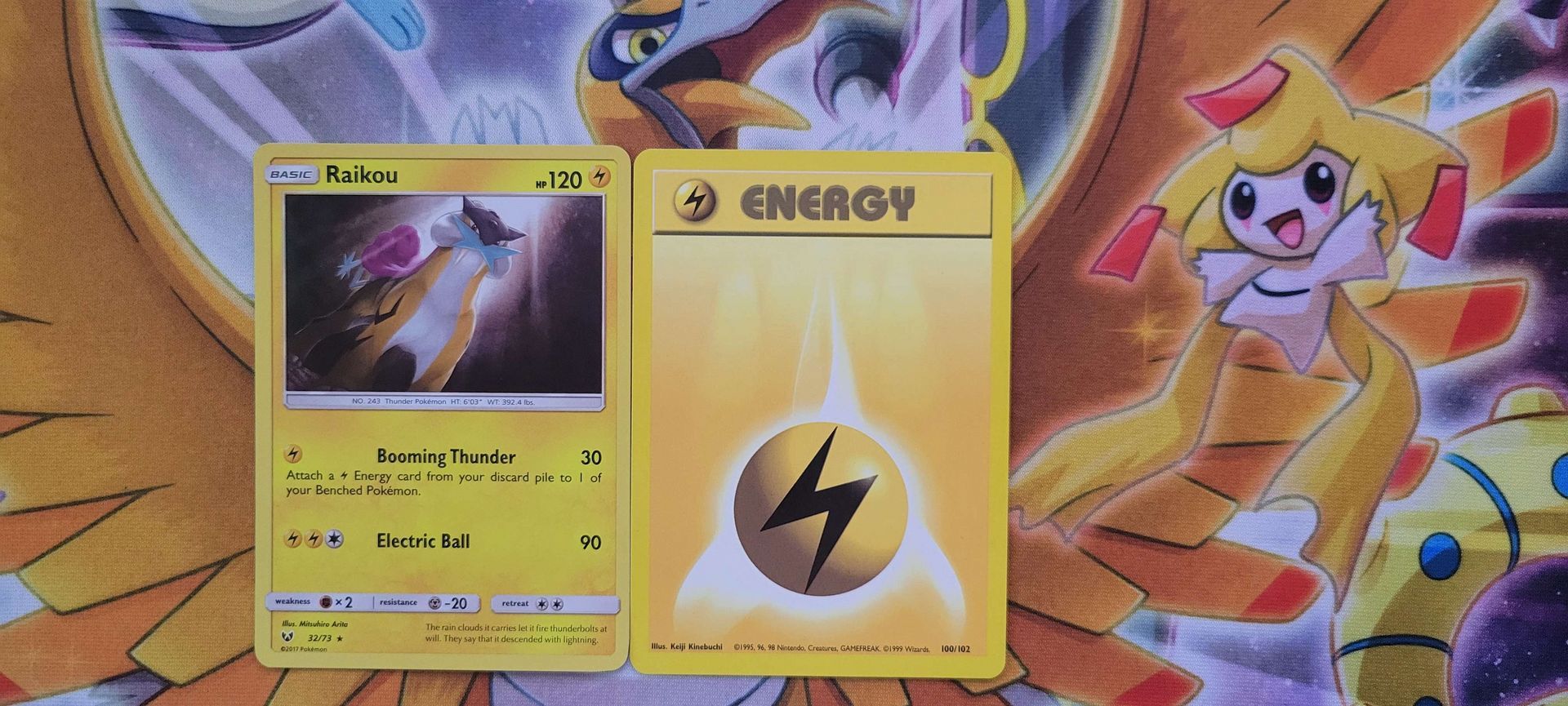
Now that we are out of starter territory, let's continue with our fourth Basic Energy card: Lightning Energy. Lightning Energy has some real potential when it comes to battling it out with your friends or even in competitive play.
Lightning Energy Breakdown:
- Each Lightning Energy card produces either one single unit of Lightning Energy or one Colorless Energy.
- You can identify a Lightning Energy card by the lightning bolt symbol.
- Lightning Energy cards enable Lightning-type Pokémon to use their attacks. Lightning Pokémon are also very strong, so when building your deck around the Lightning Energy card, make sure you are well-equipped because when you are attacking, trust me, sparks are going to be flying.
-
Type Advantage: Lightning-type Pokémon often have attacks that exploit the weaknesses of Water-type Pokémon, which are common in the TCG. This provides Lightning decks with a strategic advantage against opponents using Water types.
-
Speed and Agility: Lightning-type Pokémon may have access to fast and agile moves, allowing for quick and efficient gameplay. This speed can catch opponents off guard and control the pace of the game.
-
Energy Acceleration: Some Lightning-type Pokémon and related cards provide energy acceleration, enabling players to power up their Pokémon rapidly. This acceleration is crucial for executing powerful attacks early in the game.
-
Paralysis Effects: Lightning-type moves in the TCG may have effects that induce the Paralysis condition on the opponent's Pokémon. This control aspect can disrupt the opponent's strategy and limit their options.
-
Weakness to Ground-Type Pokémon: Lightning-type Pokémon often have a weakness to Ground-type Pokémon in the TCG. Decks with strong Ground-type attackers can exploit this weakness, dealing extra damage to Lightning Pokémon.
-
Dependence on Special Energy: Some Lightning-type Pokémon may rely on specific Lightning-type special energy cards for optimal performance. Dependence on special energy makes them vulnerable to disruption from cards that target energy attachments.
-
Limited Defensive Options: Lightning decks may prioritize offense over defense, leaving them vulnerable to strategies that disrupt their energy acceleration or target key Pokémon.
-
Common Weaknesses: Lightning-type Pokémon may share common weaknesses with other types, such as Fighting or Rock. This commonality can make them susceptible to specific strategies and cards that exploit these weaknesses.
5. Psychic Energy
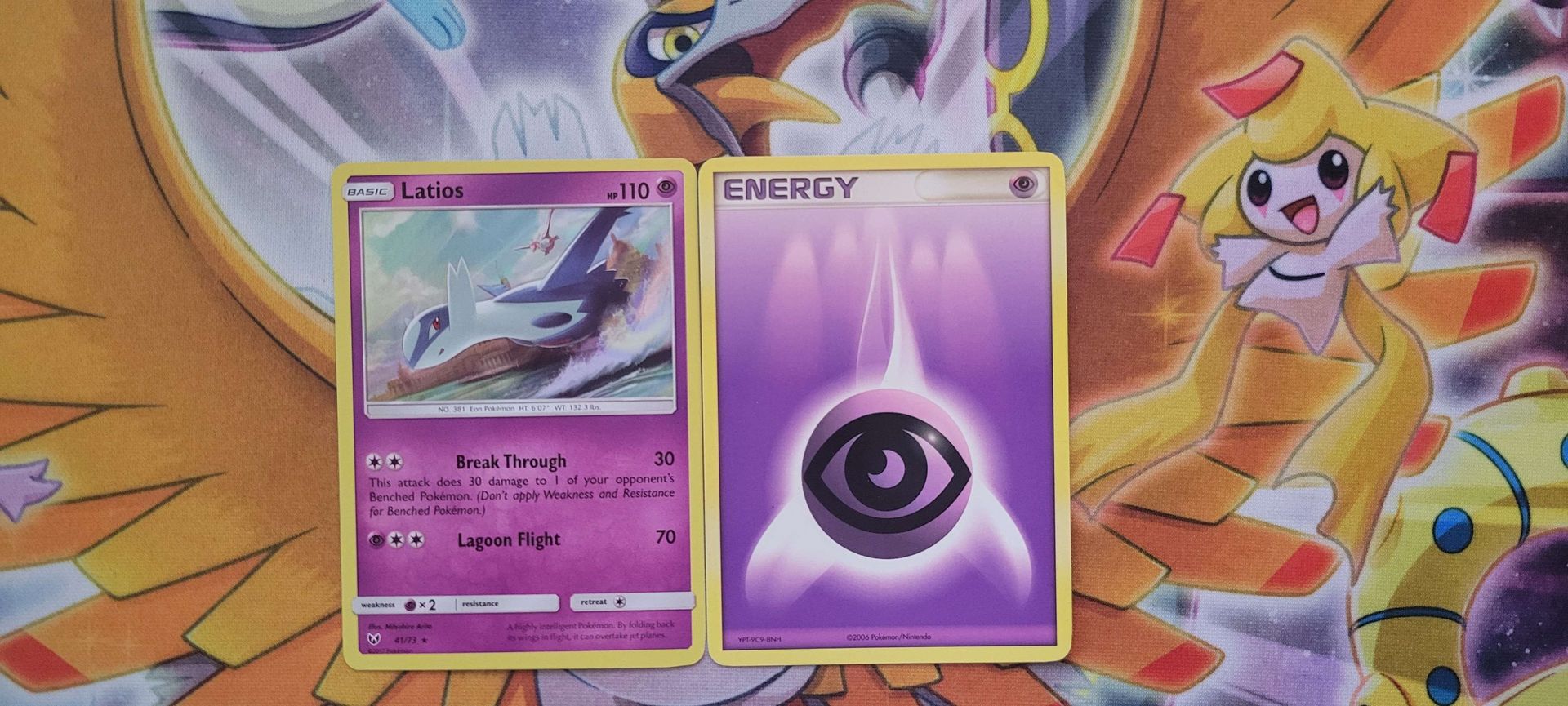
We have reached number five on the list, which can arguably be considered one of the best Basic Energy cards: Psychic Energy. If you are a competitive player or consider yourself someone who enjoys crazy combos, Psychic Energy is probably for you. Psychic Energy cards are extremely powerful, and there is always at least usually one Psychic-type Pokémon deck at the very top of Pokémon tournaments.
Psychic Energy Breakdown:
- Each Psychic Energy card produces either one single unit of Psychic Energy or one Colorless Energy.
- You can identify a Psychic Energy card by the purple eye symbol.
- Psychic Energy cards enable Psychic-type Pokémon to use their attacks. Psychic-type Pokémon are unbelievably strong and pack a huge punch in battle. If you are considering making a Psychic-type Pokémon deck, make sure you have the perfect amount of Psychic Energy cards, and you can create one of the strongest decks in the game!
-
Type Advantage: Psychic-type Pokémon often have attacks that exploit the weaknesses of Fighting-type Pokémon, which are common in the TCG. This provides Psychic decks with a strategic advantage against opponents using Fighting types.
-
Special Conditions: Psychic-type moves in the TCG may have effects that induce special conditions, such as Confusion or Sleep, on the opponent's Pokémon. This control aspect can disrupt the opponent's strategy and limit their options.
-
Energy Manipulation: Some Psychic-type Pokémon and related cards have abilities that allow for energy manipulation, disrupting the opponent's energy attachments or denying them access to certain moves.
-
Resistance to Psychic Attacks: Psychic types are resistant to Psychic-type attacks, reducing the damage they take from such moves. This resistance can be advantageous in battles against other Psychic-type Pokémon.
-
Weakness to Dark-Type Pokémon: Psychic-type Pokémon often have a weakness to Dark-type Pokémon in the TCG. Decks with strong Dark-type attackers can exploit this weakness, dealing extra damage to Psychic Pokémon.
-
Dependence on Special Energy: Some Psychic-type Pokémon may rely on specific Psychic-type special energy cards for optimal performance. Dependence on special energy makes them vulnerable to disruption from cards that target energy attachments.
-
Limited Offensive Coverage: Psychic decks may have limited offensive coverage against certain types. Building a diverse deck that can handle various threats is crucial.
-
Common Weaknesses: Psychic-type Pokémon may share common weaknesses with other types, such as Ghost or Bug. This commonality can make them susceptible to specific strategies and cards that exploit these weaknesses.
6. Fighting Energy
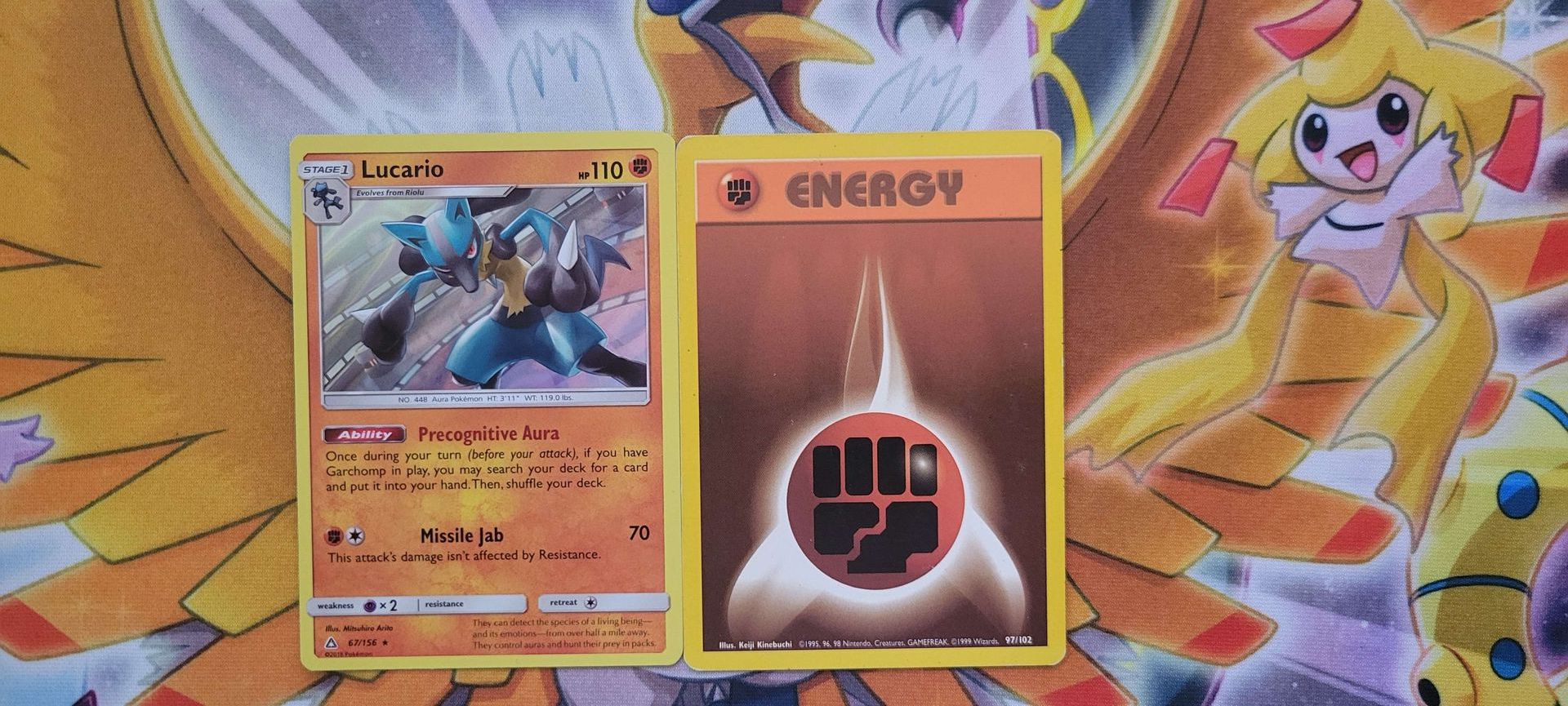
Moving on to number six, we have Fighting Energy. Personally, Fighting Energy cards are not my favorite type of energy or type, but they do have their place. Fighting Energy cards are important in all Fighting decks, and they really do pack a punch.
Fighting Energy Breakdown:
- Each Fighting Energy card produces either one single unit of Fighting Energy or one Colorless Energy.
- You can identify a Fighting Energy card by the fist symbol.
- Fighting Energy cards enable Fighting-type Pokémon to use their attacks. Fighting-type Pokémon utilize Fighting Energy cards to land jabs, punches, and kicks. So when building your deck around Fighting-type Pokémon, be sure not to leave your opponent too many bruises.
-
Type Advantage: Fighting-type Pokémon often have attacks that exploit the weaknesses of Normal, Ice, Rock, Dark, and Steel-type Pokémon, which are common in the TCG. This provides Fighting decks with a strategic advantage against opponents using these types.
-
High Damage Output: Fighting-type Pokémon frequently have attacks with high damage output, allowing them to quickly eliminate opposing Pokémon. This high damage can put pressure on the opponent and control the pace of the game.
-
Energy Efficiency: Many Fighting-type attacks have relatively low energy costs, making them efficient in terms of energy consumption. This allows for consistent and rapid use of powerful moves.
-
Versatility in Moves: Fighting-type Pokémon may have a variety of moves, including those that deal damage, provide support, or disrupt the opponent's strategy. This versatility enhances the tactical options available to players.
-
Weakness to Psychic-Type Pokémon: Fighting-type Pokémon often have a weakness to Psychic-type Pokémon in the TCG. Decks with strong Psychic-type attackers can exploit this weakness, dealing extra damage to Fighting Pokémon.
-
Limited Defensive Options: Fighting decks may prioritize offense over defense, leaving them vulnerable to strategies that disrupt their energy acceleration or target key Pokémon.
-
Dependence on Special Energy: Some Fighting-type Pokémon may rely on specific Fighting-type special energy cards for optimal performance. Dependence on special energy makes them vulnerable to disruption from cards that target energy attachments.
-
Common Weaknesses: Fighting-type Pokémon may share common weaknesses with other types, such as Flying or Fairy. This commonality can make them susceptible to specific strategies and cards that exploit these weaknesses.
7. Darkness Energy
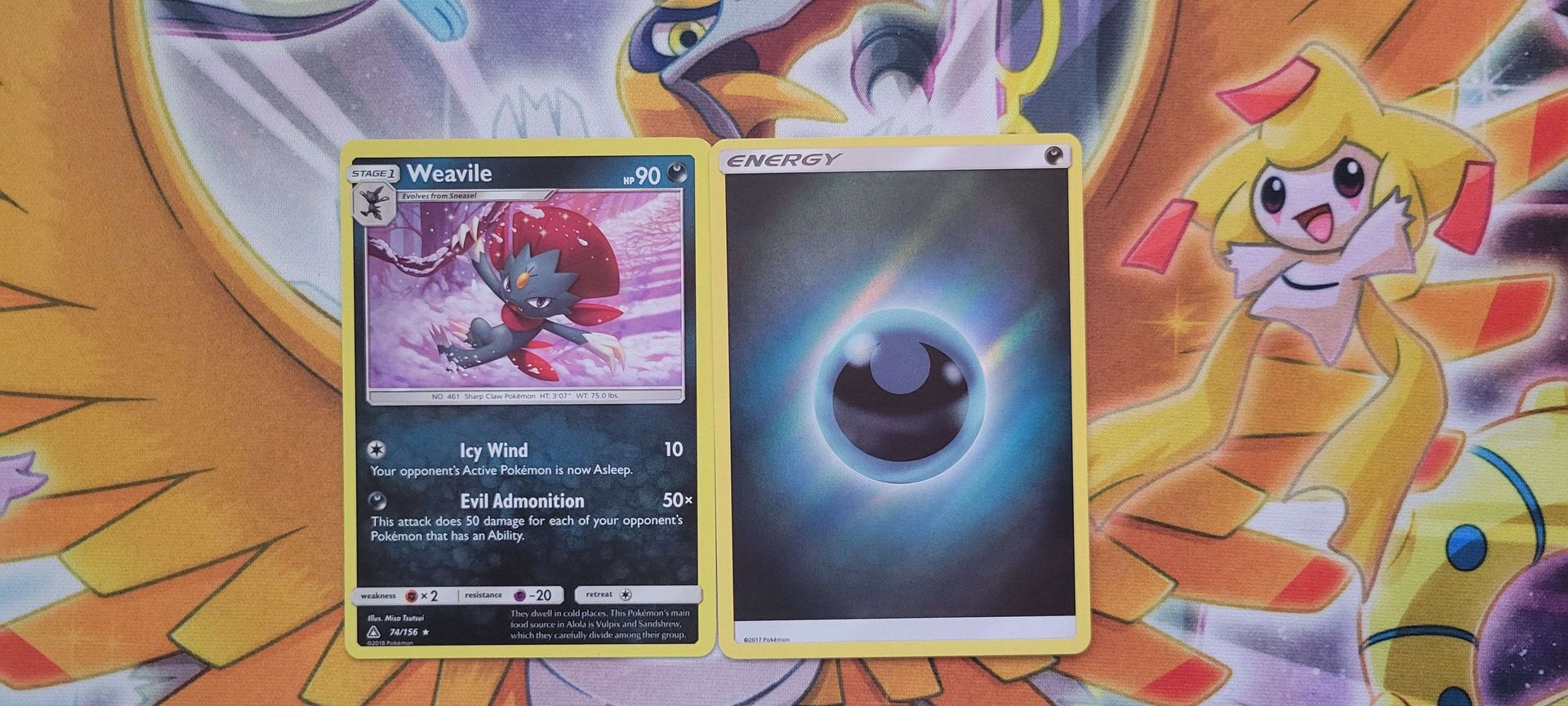
Coming in at number seven is my personal favorite: Darkness Energy. If you like super combos and really strong Pokémon, then building a deck around Dark-type Pokémon and Darkness Energy cards is a must! I have had so much fun over the years messing around with the Dark archetype, and I must say it's definitely one I recommend trying out.
Darkness Energy Breakdown:
- Each Darkness Energy card produces either one single unit of Darkness Energy or one Colorless Energy.
- You can identify a Darkness Energy card by the upside-down crescent moon.
- Darkness Energy cards enable Dark-type Pokémon to use their attacks. Darkness Energy cards really put your mind to the test; they are usually found in combo decks and revolve around Dark-type Pokémon. Shoutout to my favorite legendary, Darkrai. When I used to play competitively, I only used Dark-type Pokémon and Energy cards.
-
Type Advantage: Dark-type Pokémon often have attacks that exploit the weaknesses of Psychic and Ghost-type Pokémon, which are common in the TCG. This provides Dark decks with a strategic advantage against opponents using these types.
-
Disruption and Control: Dark-type moves in the TCG may have effects that disrupt the opponent's strategy, such as discarding cards from their hand or applying status conditions. This control aspect can give Dark decks a tactical edge.
-
Versatility in Moves: Dark-type Pokémon may have a variety of moves, including those that deal damage, draw cards, or disrupt the opponent's setup. This versatility enhances the tactical options available to players.
-
Resistance to Psychic Attacks: Dark types are resistant to Psychic-type attacks, reducing the damage they take from such moves. This resistance can be advantageous in battles against Psychic-type Pokémon.
-
Weakness to Fighting-Type Pokémon: Dark-type Pokémon often have a weakness to Fighting-type Pokémon in the TCG. Decks with strong Fighting-type attackers can exploit this weakness, dealing extra damage to Dark Pokémon.
-
Dependence on Special Energy: Some Dark-type Pokémon may rely on specific Dark-type special energy cards for optimal performance. Dependence on special energy makes them vulnerable to disruption from cards that target energy attachments.
-
Common Weaknesses: Dark-type Pokémon may share common weaknesses with other types, such as Bug or Fighting. This commonality can make them susceptible to specific strategies and cards that exploit these weaknesses.
-
Limited Defensive Options: Dark decks may prioritize offense over defense, leaving them vulnerable to strategies that disrupt their energy acceleration or target key Pokémon.
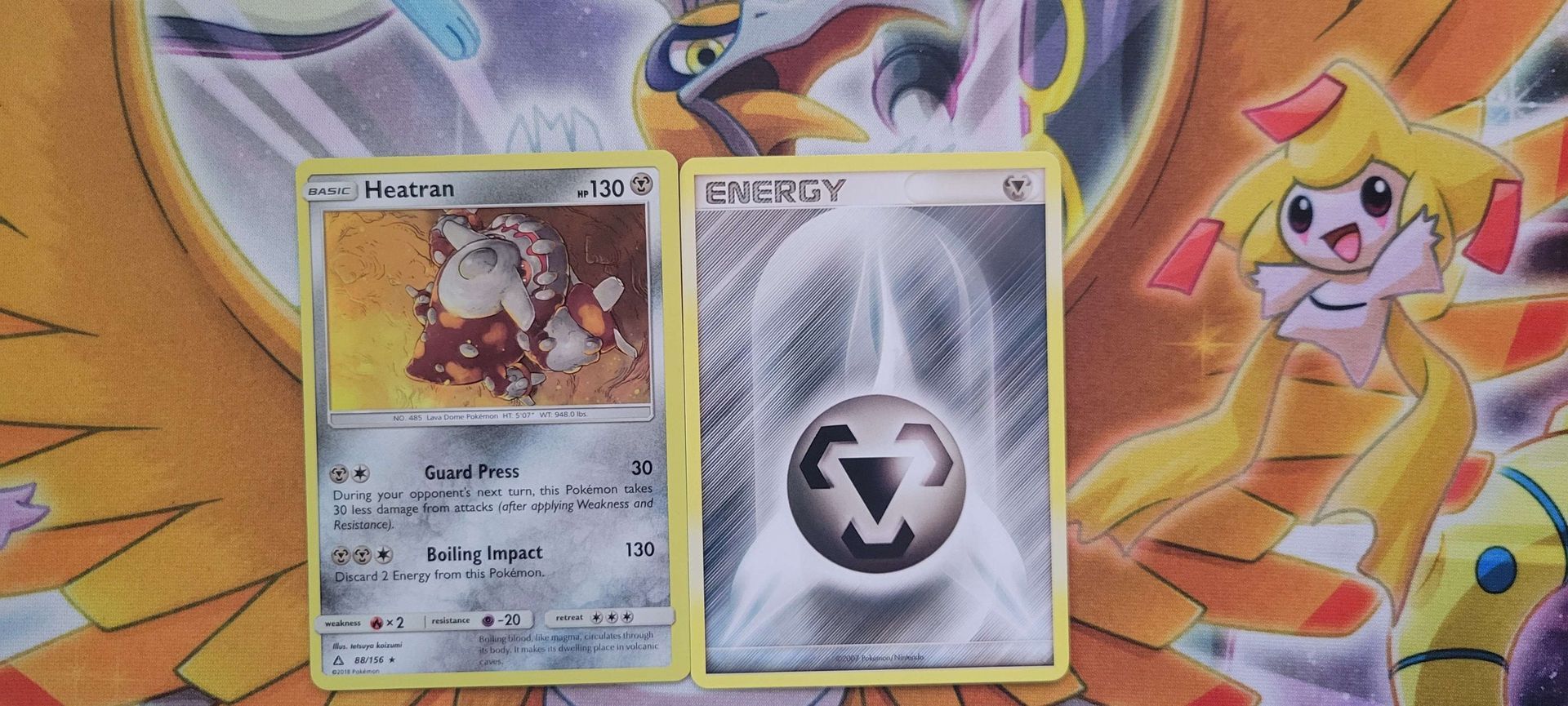
The number eight spot for Basic Energy cards is Metal Energy. Metal Energy is an interesting one; I personally don't see many people run Metal-type Pokémon, but nonetheless, it's still a basic energy and has its place in the Pokémon meta, so of course, we will cover it!
Metal Energy Breakdown:
- Each Metal Energy card produces either one single unit of Metal Energy or one Colorless Energy.
- You can identify a Metal Energy Card by its gray and metallic color; it's also the only Basic Energy card with a triangle in the middle of it.
- Metal Energy cards enable Metal-type Pokémon to use their attacks. Metal Energy cards are, I would say, for a defensive playstyle, seeing how they are weak against Fire Energy. It makes for a harder deck in the current climate, but for casual play and creating awesome theme decks, Metal has some truly awesome cards. Make sure to include plenty of Metal Energy cards.
-
Type Advantage: Metal-type Pokémon often have attacks that exploit the weaknesses of Fairy and Ice-type Pokémon, which are common in the TCG. This provides Metal decks with a strategic advantage against opponents using these types.
-
High Defense: Metal-type Pokémon frequently have high HP (hit points) and can resist damage from certain types, making them durable and challenging to knock out. This high defense allows them to withstand attacks and stay on the field longer.
-
Resistance to Psychic and Dragon Attacks: Metal types are resistant to Psychic and Dragon-type attacks, reducing the damage they take from such moves. This resistance can be advantageous in battles against Pokémon of these types.
-
Versatility in Moves: Metal-type Pokémon may have a variety of moves, including those that deal damage, provide support, or disrupt the opponent's strategy. This versatility enhances the tactical options available to players.
-
Weakness to Fire-Type Pokémon: Metal-type Pokémon often have a weakness to Fire-type Pokémon in the TCG. Decks with strong Fire-type attackers can exploit this weakness, dealing extra damage to Metal Pokémon.
-
Dependence on Special Energy: Some Metal-type Pokémon may rely on specific Metal-type special energy cards for optimal performance. Dependence on special energy makes them vulnerable to disruption from cards that target energy attachments.
-
Limited Offensive Options: Metal decks may face challenges in terms of offensive coverage against certain types. Building a diverse deck that can handle various threats is crucial.
-
Common Weaknesses: Metal-type Pokémon may share common weaknesses with other types, such as Ground or Fighting. This commonality can make them susceptible to specific strategies and cards that exploit these weaknesses.
9. Fairy Energy
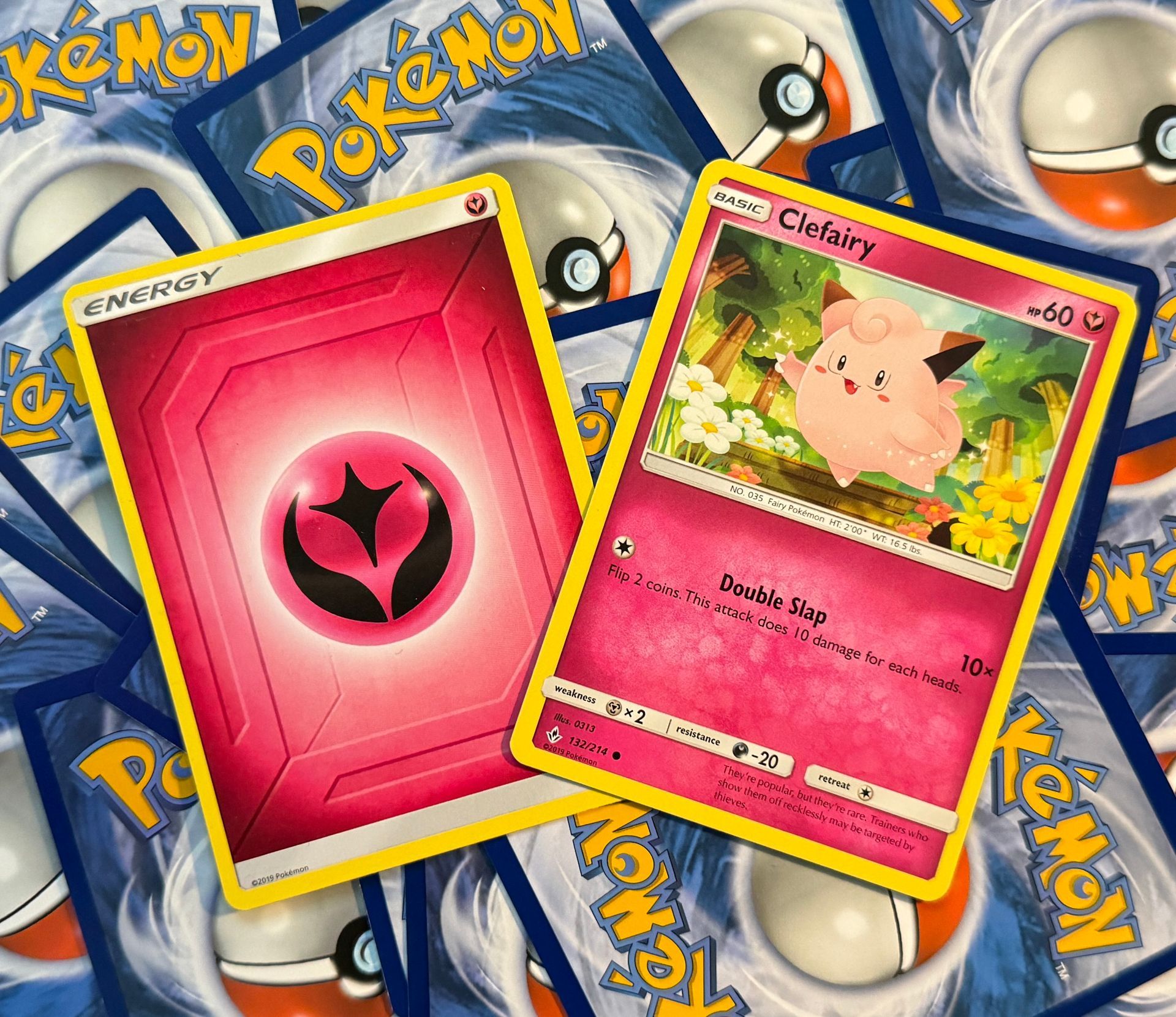
Finally, last but not least, we have Fairy Energy. Fairy Energy has actually rotated out in the Sword & Shield Series, so it technically no longer exists. For casual play, however, Fairy Energy is still considered one of the Basic Energy cards, so I went ahead and covered it for anyone who likes staying charmed in the past.
Fairy Energy Breakdown:
- Each Fairy Energy card produces either one single unit of Grass Fairy or one Colorless Energy.
- You can identify a Fairy Energy card by looking for the pink, angel-like wing symbol.
- Fairy Energy cards enable Fairy-type Pokémon to use their attacks. Now, because Fairy Energy cards have rotated out along with Fairy-type Pokémon, it might be hard to obtain some of these cards. Over time, Fairy Pokémon cards could become collectible. If you do plan on playing a Fairy-type Pokémon deck, make sure you have the correct amount of Fairy Energy cards, as they can tend to be resource-heavy.
-
Type Advantage: Fairy-type Pokémon often have attacks that exploit the weaknesses of Dragon and Dark-type Pokémon, which are common in the TCG. This provides Fairy decks with a strategic advantage against opponents using these types.
-
Healing Abilities: Some Fairy-type Pokémon have access to moves or abilities that allow them to heal themselves or other Pokémon on the field. This healing capability enhances their survivability in battles.
-
Disruption and Control: Fairy-type moves in the TCG may have effects that disrupt the opponent's strategy, such as preventing damage or altering the opponent's abilities. This control aspect can give Fairy decks a tactical edge.
-
Resistance to Dark Attacks: Fairy types are resistant to Dark-type attacks, reducing the damage they take from such moves. This resistance can be advantageous in battles against Dark-type Pokémon.
-
Weakness to Steel and Poison Pokémon: Fairy-type Pokémon often have a weakness to Steel and Poison-type Pokémon in the TCG. Decks with strong Pokémon of these types can exploit this weakness, dealing extra damage to Fairy Pokémon.
-
Dependence on Special Energy: Some Fairy-type Pokémon may rely on specific Fairy-type special energy cards for optimal performance. Dependence on special energy makes them vulnerable to disruption from cards that target energy attachments.
-
Limited Offensive Options: Fairy decks may face challenges in terms of offensive coverage against certain types. Building a diverse deck that can handle various threats is crucial.
-
Common Weaknesses: Fairy-type Pokémon may share common weaknesses with other types, such as Steel or Poison. This commonality can make them susceptible to specific strategies and cards that exploit these weaknesses.
Special Energy Cards: Consistency and Competitive
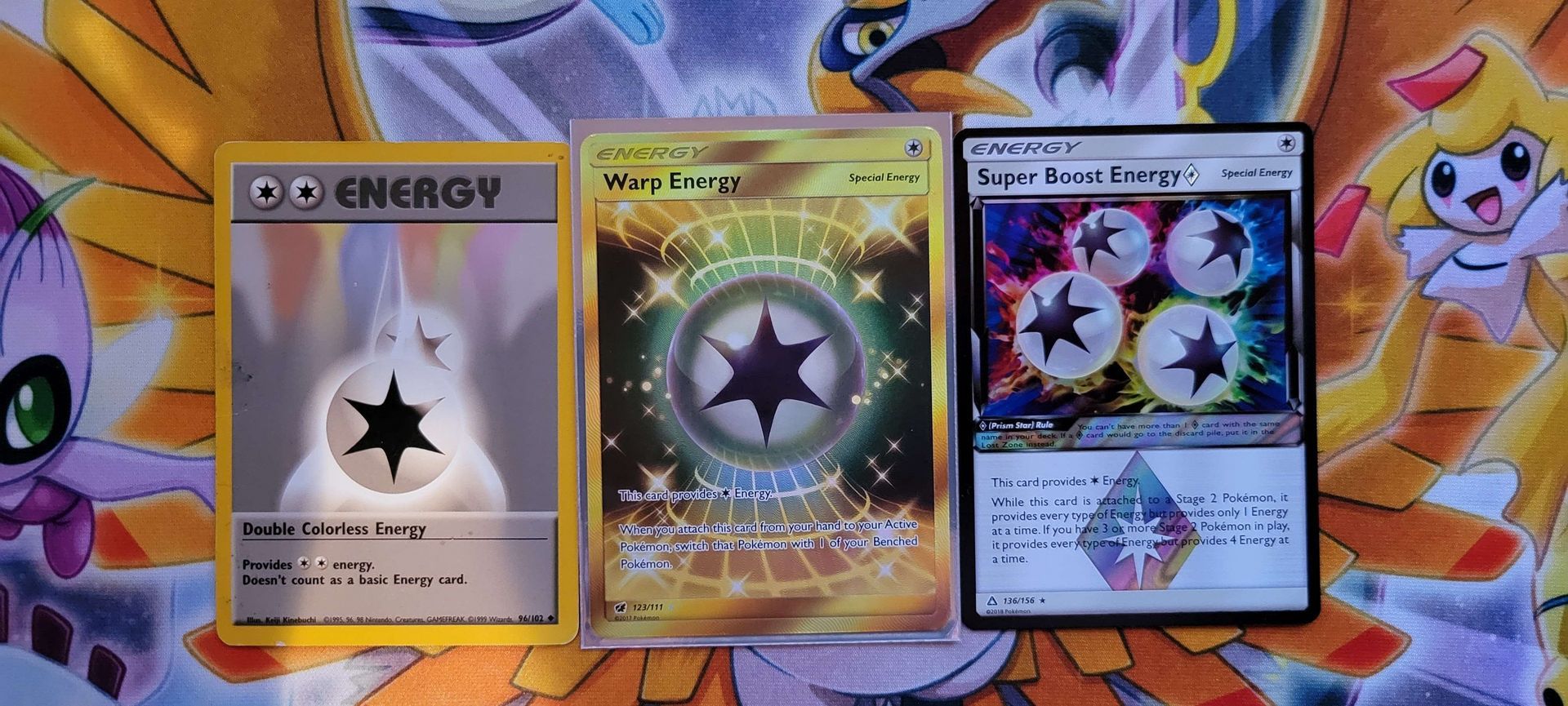
Special Energy cards introduce an extra layer of strategy to the Pokémon TCG. These cards often bring additional effects or conditions into play, allowing trainers to tailor their decks to specific tactics.
Remember when I said there were ten Basic Energy card types? That is only true to a certain extent. While there are Normal-type Pokémon, Normal Energy cards have never really been considered "Basic Energy" and would technically be considered the first Special Energy.
In the current year, there are almost over 90 Special Energy cards in the Pokémon Trading Card Game, with usually one to four Special Energy cards being released with each new set. Thankfully, as big as that number is, the Pokémon Company has a Standard Format Rotation they do, which rotates out cards every year. This means most of these Special Energy cards you will never see.
The variety of Special Energy cards is obviously massive, especially if you are playing casually or in a format where all cards are playable. Still, I do want to go over a couple of examples so you have an idea of what a Special Energy card can do.
Special Energy Example #1: Warp Energy
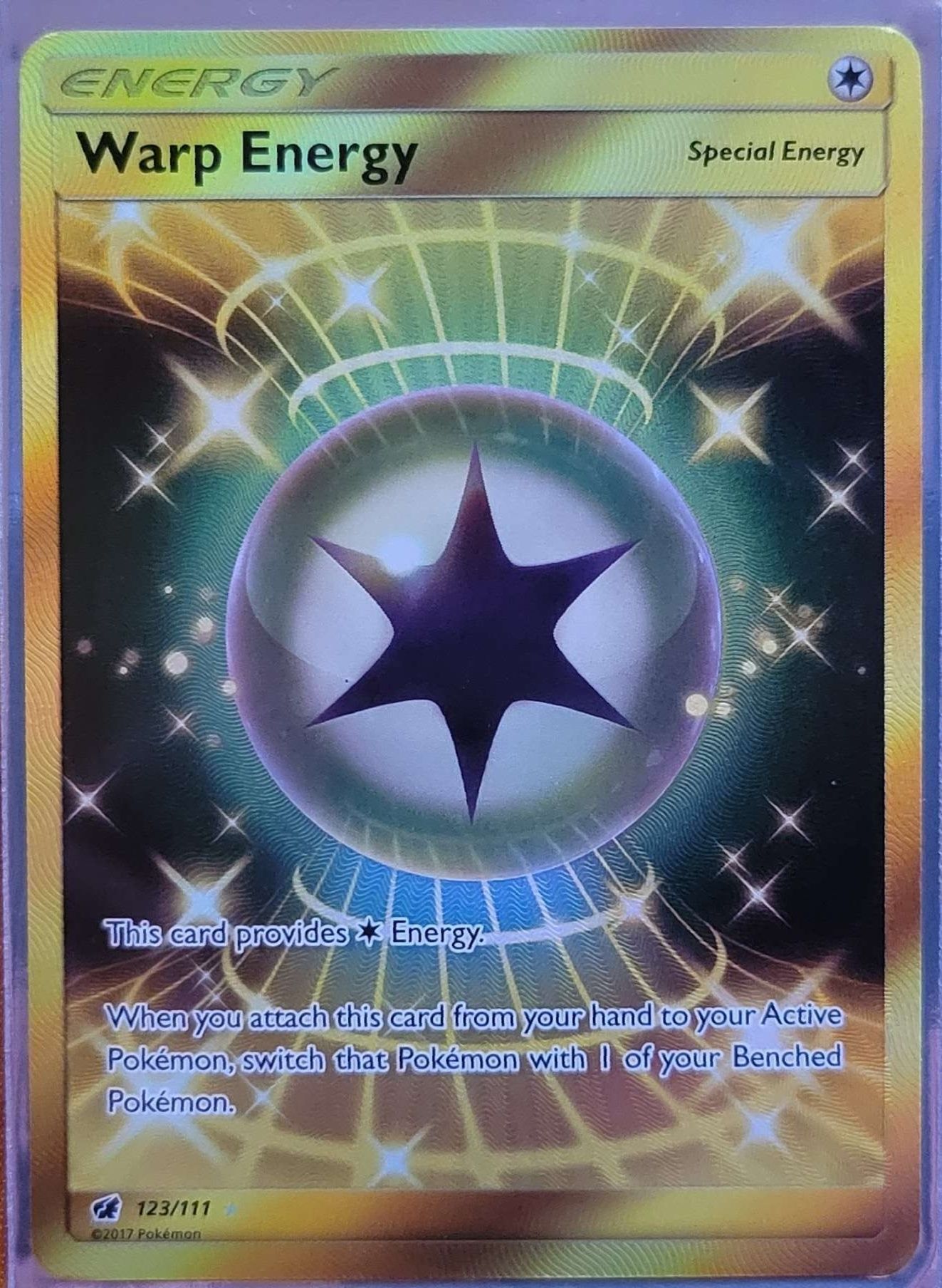
In our first example, we are going to use the Special Energy card Warp Energy. I thought this would be a great example to showcase what Special Energy cards typically do, as you can see, not only does it provide Basic Normal Energy, but it also has an additional effect, which is essentially what Special Energy cards give you.
- Provides: This card provides One Colorless Energy.
- Description: When you attach this card from your hand to your Active Pokémon, switch that Pokémon with one of your Benched Pokémon.
Special Energy Example #2: Cyclone Energy
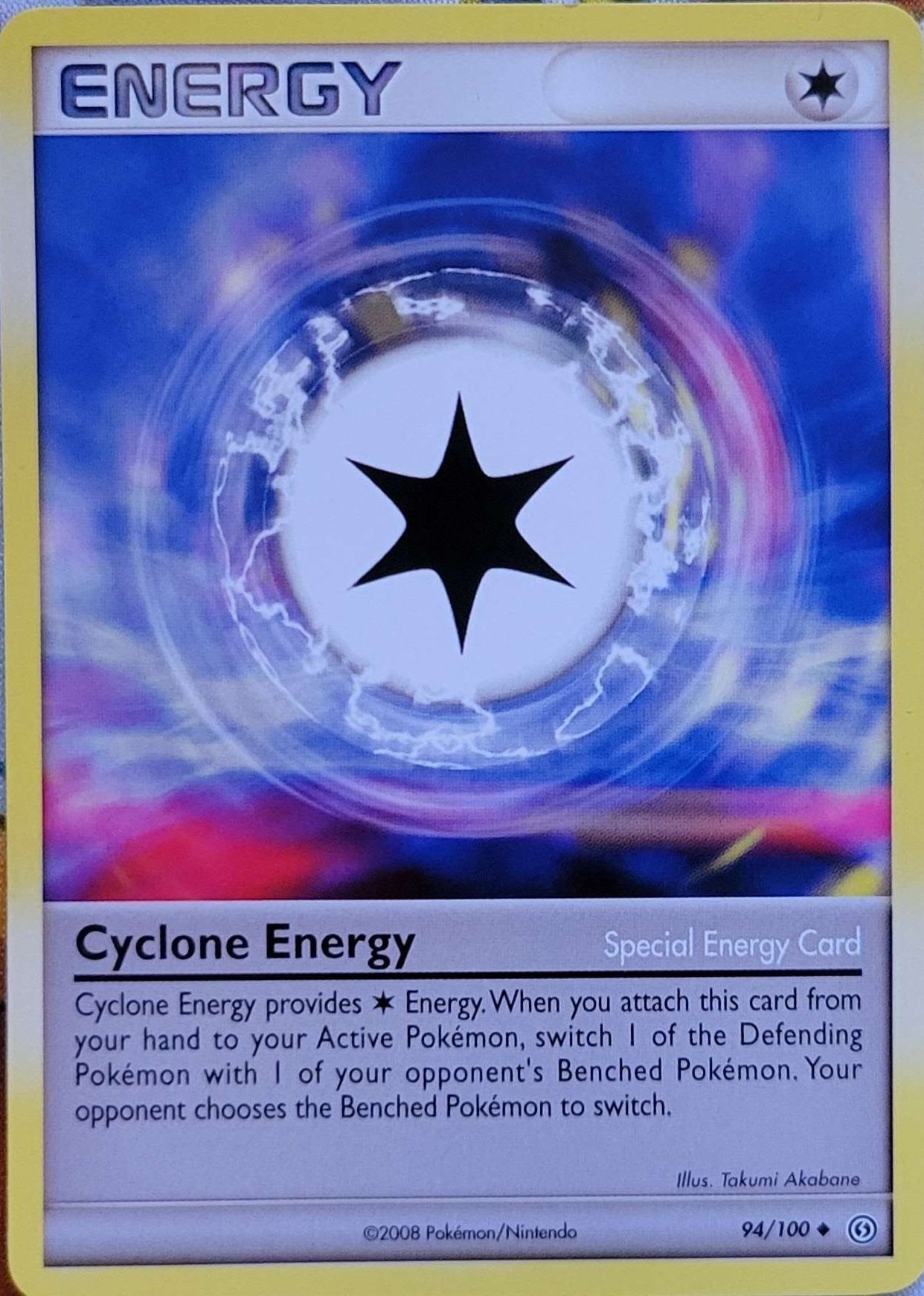
In our second example, we are going to use the Special Energy card Cyclone Energy. Like example number one, this Special Energy card not only gives Energy but also provides an additional effect. This effect is a combination of the previous example but slightly different.
- Provides: This card provides One Colorless Energy.
- Description: When you attach this card from your hand to your Active Pokémon, switch one of the Defending Pokémon with one of your opponent's Benched Pokémon. Your opponent chooses the Benched Pokémon to switch.
Now that you have an idea of what Special Energy cards are, there is honestly a Special Energy for every kind of deck or any situation you might need it. You tend to see Special Energy cards in decks that are going for really awesome combinations in tournament play or decks that are synchronizing with other Pokémon card types. Special Energy cards tend to do what Basic Energy cards can't, and that is give you consistency and alternative playmaking potential when you are in a rough spot.
Like I said, there are over 90 Special Energy cards in the current Pokémon TCG, so I have prepared a table that will show you every Special Energy card that has been released in set order.
Wizards of the Coast: Special Energy Cards
Below is a table of all the Special Energy cards that Wizards of the Coast made before the Pokémon Company took control in 2003.
| Card name | Provides | Debut expansion |
|---|---|---|
| Double Colorless Energy | Two Colorless Energy | Base Set |
| Rainbow Energy | One Color or Any One Basic Energy | Team Rocket |
| Full Heal Energy | One Colorless Energy | Team Rocket |
| Potion Energy | One Colorless Energy | Team Rocket |
| Darkness Energy | One Darkness Energy | Neo Genesis |
| Metal Energy | One Metal Energy | Neo Genesis |
| Recycle Energy | One Colorless Energy | Neo Genesis |
| Miracle Energy | Two of Any Basic Energy | Neo Destiny |
| Boost Energy | Three Colorless Energy | Aquapolis |
| Crystal Energy | One Colorless Energy or Any Basic Energy | Aquapolis |
| Warp Energy | One Colorless Energy | Aquapolis |
| Bounce Energy | Two Colorless Energy | Skyridge |
| Cyclone Energy | One Colorless Energy | Skyridge |
| Retro Energy | One Colorless Energy | Skyridge |
The Pokémon Company: Special Energy Cards
After 2003 is when The Pokémon Company started creating there own pokemon cards and along with those an ever expanding list of Special Energy cards because of the sheer length of the list I am going to break it up into multiple tables, but the tables will stay in chronological order from when each set was released.
| Card name | Provides | Opening Release |
|---|---|---|
| Multi Energy | One Colorless Energy or One of Any Basic Energy | EX Sandstorm |
| Aqua Energy | Two Water Energy, Water Energy and Darkness Energy, or Two Darkness Energy | EX Team Magma vs Team Aqua |
| Magma Energy | Two Fighting Energy, One Fighting One Darkness, or Two Darkness Energy | EX Team Magma vs Team Aqua |
| Double Rainbow Energy | Two of Any Basic Energy | EX Team Magma vs Team Aqua |
| Dark Metal Energy | One Darkness Energy or One Metal Energy | EX Team Rocket Returns |
| R Energy | Two Darkness Energy | EX Team Rocket Returns |
| Heal Energy | One Colorless Energy | EX Deoxys |
| Scramble Energy | One Colorless Energy or Three of Any Basic Energy | EX Deoxys |
| Holon Energy FF | One Colorless Energy | EX Delta Species |
| Holon Energy GL | One Colorless Energy | EX Delta Species |
| Holon Energy WP | One Colorless Energy | EX Delta Species |
| React Energy | One Colorless Energy | EX Legend Maker |
| δ Rainbow Energy | One Colorless Energy or One of Any Basic Energy | EX Holon Phantoms |
| Call Energy | One Colorless Energy | Majestic Dawn |
| Health Energy | One Colorless Energy | Majestic Dawn |
| Recover Energy | One Colorless Energy | Majestic Dawn |
| SP Energy | One Colorless Energy or Any One Basic Energy | Rising Rivals |
| Upper Energy | One Colorless Energy or Two Colorless Energy | Rising Rivals |
| Rescue Energy | One Colorless Energy | Triumphant |
| Prism Energy | One Colorless Energy or Any One Basic Energy | Next Destinies |
| Blend Energy | One Colorless Energy, One Grass Energy, One Fire Energy, One Psychic Energy, or One Darkness Energy | Dragons Exalted |
| Blend Energy | One Colorless Energy, One Water Energy, One Lighting Energy, One Fighting Energy, or One Metal Energy | Dragons Exalted |
| Plasma Energy | One Colorless Energy | Plasma Storm |
| Herbal Energy | One Grass Energy | Furious Fists |
| Strong Energy | One Fighting Energy | Furious Fists |
| Mystery Energy | One Psychic Energy | Phantom Forces |
| Shield Energy | One Metal Energy | Primal Clash |
| Wonder Energy | One Fairy Energy | Primal Clash |
| Double Aqua Energy | Two Water Energy | Double Crisis |
| Continued | Continued | Continued |
|---|---|---|
| Double Magma Energy | Two Fighting Energy | Double Crisis |
| Double Dragon Energy | Two of Any Basic Energy | Roaring Skies |
| Flash Energy | One Lighting Energy | Ancient Origins |
| Dangerous Energy | One Darkness Energy | Ancient Origins |
| Burning Energy | One Fire Energy | BREAKthrough |
| Splash Energy | One Water Energy | BREAKpoint |
| Counter Energy | One Colorless Energy or Two of Any Basic Energy | Crimson Invasion |
| Super Boost Energy | One Colorless Energy, One of Any Basic Energy, or Four of Any Basic Energy | Ultra Prism |
| Unit Energy | One Colorless Energy, One Grass Energy, One Fire Energy, or One Water Energy | Ultra Prism |
| Unit Energy | One Colorless Energy, One Lighting Energy, One Psychic Energy, or One Metal Energy | Ultra Prism |
| Unit Energy | One Colorless Energy, One Fighting Energy, One Darkness Energy, or One Fairy Energy | Forbidden Light |
| Beast Energy | One Colorless Energy, or One of Any Basic Energy | Forbidden Light |
| Memory Energy | One Colorless Energy | Lost Thunder |
| Triple Acceleration Energy | Three Colorless Energy | Unbroken Bonds |
| Weakness Guard Energy | One Colorless Energy | Unified Minds |
| Draw Energy | One Colorless Energy | Cosmic Eclipse |
| Aurora Energy | One of Any Basic Energy | Sword & Shield |
| Capture Energy | One Colorless Energy | Rebel Clash |
| Horror Psychic Energy | One Psychic Energy | Rebel Clash |
| Speed Lightning Energy | One Lighting Energy | Rebel Clash |
| Twin Energy | One Colorless Energy or Two Colorless Energy | Rebel Clash |
| Heat Fire Energy | One Fire Energy | Darkness Ablaze |
| Hiding Darkness Energy | One Darkness Energy | Darkness Ablaze |
| Powerful Colorless Energy | One Colorless Energy | Darkness Ablaze |
| Aromatic Grass Energy | One Grass Energy | Vivid Voltage |
| Coating Metal Energy | One Metal Energy | Vivid Voltage |
| Stone Fighting Energy | One Fighting Energy | Vivid Voltage |
| Wash Water Energy | One Water Energy | Vivid Voltage |
| Single Strike Energy | One Fighting or One Darkness Energy | Battle Styles |
| Continued | Continued | Continued |
|---|---|---|
| Rapid Strike Energy | Two Water Energy, One Water Energy, One Fighting Energy, or Two Fighting Energy | Battle Styles |
| Impact Energy | One of Any Basic Energy | Chilling Reign |
| Lucky Energy | One Colorless Energy | Chilling Reign |
| Spiral Energy | One of Any Basic Energy | Chilling Reign |
| Treasure Energy | One Colorless Energy | Evolving Skies |
| Fusion Strike Energy | One of Any Basic Energy | Fusion Strike |
| Double Turbo Energy | Two Colorless Energy | Brilliant Stars |
| Gift Energy | One Colorless Energy | Lost Origin |
| Regenerative Energy | One Colorless Energy | Silver Tempest |
| V Guard Energy | One Colorless Energy | Silver Tempest |
| Jet Energy | One Colorless Energy | Paldea Evolved |
| Luminous Energy | One Colorless Energy ,or One of Any Basic Energy | Paldea Evolved |
| Reversal Energy | One Colorless Energy, or Three of Any Basic Energy | Paldea Evolved |
| Therapeutic Energy | One Colorless Energy | Paldea Evolved |
| Medical Energy | One Colorless Energy | Paradox Rift |
| Neo Upper Energy | One Colorless Energy, or Two of Any Basic Energy | Wild Force |
| Mist Energy | One Colorless Energy | Cyber Judge |
Frequently Asked Questions
Article Topics:
About the author: Kamryn Kirwan
Card collector, gamer, Pokémon enthusiast

Kamryn Kirwan is a passionate writer for TCG Review who loves gaming and collecting cards. He enjoys sharing his knowledge and expertise with the gaming community, and if you're looking to read something that's more than just generic tips, he's got your back.

